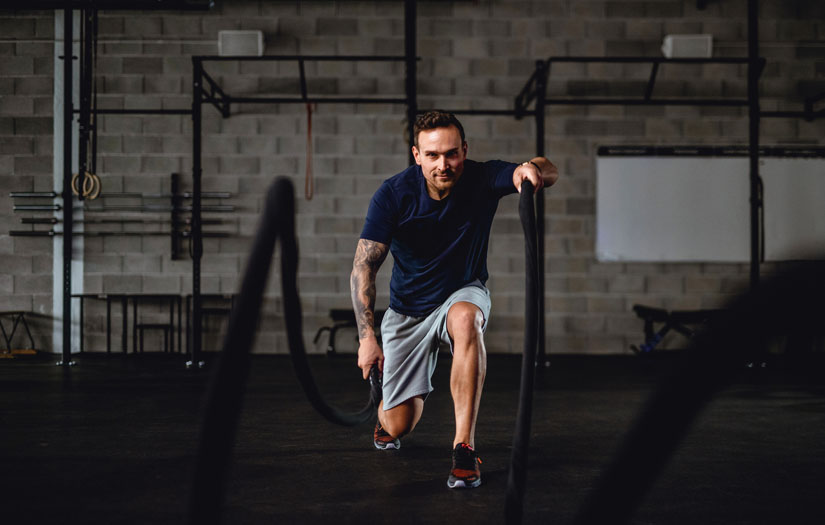New year, new you! With that fresh mentality to set new intentions and new goals, finally committing to a long-term fitness plan might be high up on your list. But with all those other goals on your list, you may find yourself crunched for time, and the last thing you want to do is set yourself up for failure when it comes to your physical health.
So, what if there was a quick, exciting, and dynamic solution to your fitness New Year’s resolution? One you can stick too and never get bored… Sounds too good to be true? Not at all! Get ready to incorporate circuit training into your everyday routine and love every second of it.
What is Circuit Training?
Circuit training is a form of body conditioning that combines endurance training, strength training, and high intensity aerobics. It typically involves several different exercises that target various muscle groups, and each exercise has a target rep range or time cap in which the exercise must be completed. Once all exercises in a single circuit are completed, there is typically a rest period of 1-2 minutes.
Another variation of circuit training is when you have very small windows of rest of 10-30 seconds between exercises in a single circuit. Most circuits are completed 1-3 times depending on the number of exercises that are involved in a single circuit.
An Efficient Workout
Circuits can be completed in various time frames and evoke great health and fitness benefits regardless of the time devoted to it. Circuits can last between 15-60 minutes, and due to the high intensity structure, you’ll feel like you get a great workout regardless of how much time you must commit. Don’t believe it? Several studies have shown that individuals have seen major improvements in their fitness status with circuit durations of as little as 7 minutes (1)!
Decrease the Risk of Major Diseases
It’s well known that any type of physical activity can improve overall health, but what changes are seen in circuit training programs? In one study conducted in healthy, overweight middle-aged men found that high intensity circuit training showed greater improvements in blood pressure, cholesterol, and triglycerides compared to subjects that just performed low intensity circuit training or traditional endurance training (3).
In another study with type 2 diabetics, they found that a 12-week program of circuit resistance training significantly reduced HbA1c levels (4). Overall, circuit training seems to be effective and safe for both healthy and diseased populations.
Increase Strength
Several studies have shown that circuit training can elicit increases in both upper and lower body 1-rep max, making it a great exercise to target whole body fitness. Studies have shown major increases in muscle mass in both trained and untrained populations (however, untrained populations demonstrate greater improvements since they have more ability to show improvements in shorter time periods).
Circuit training induces the same anabolic signaling and maximal muscle fiber recruitment that conventional resistance training does — but without the need to use as much weight since there are shorter rest periods between sets.
Improve Heart Health and Weight Loss
One meta-analysis investigated several studies looking at the effects of circuit training on aerobic fitness and changes in body mass. They found that circuit training can improve Vo2max and endurance performance by 6.2%! They also found that circuit training elicited major changes in body composition.
From the 45 studies that were analyzed, they found that circuit training led to an average reduction of 4.3% in fat mass. The greatest fat loss outcomes were seen in groups that performed circuit training at least three times per week with higher volume training, shorter rest times, and moderate to high-intensity levels (1).
Accessible for All Fitness Levels
Like every fitness program, beginners will always demonstrate major improvements in shorter time periods. However, due to circuit training’s dynamic nature, it can always become more challenging regardless of your fitness status! Circuit training is heavily used in professional athletics to build speed, reaction time, muscular endurance, and aerobic fitness.
Even in youth populations, circuit training has been demonstrated to be extremely effective in increasing muscular and cardiovascular endurance. One study conducted on kids between the ages of 10-12 years old found that just four weeks of a circuit training program, completed twice a week showed major increases in strength and endurance (2). Furthermore, those adaptations were maintained after a four-week de-training period.
Break a Sweat
So, what are some examples of different circuit training exercises you can incorporate into your fitness routine now?
Body weight circuit
Each exercise is done for 30 seconds, with 30 seconds of rest between each exercise. A circuit is to be completed three times with three minutes rest between each circuit completion.
• Jumping squat
• Push-ups
• Skydivers
• V-sits
• High knees
• Jumping Lunges
• Plank to Push-up
• Jumping Jacks
• Side Plank Rotations
• Lateral Skaters
Full body circuit workout with weights
Each circuit is to be completed 3 times, with no rest between each exercise. 1-minute rest is to be taken between circuits.
Circuit 1:
• Goblet squats, 15 reps
• Deadlift with row, 15 reps
• Glute Bridge with chest press, 20 reps
Circuit 2:
• Squat to overhead press, 15 reps
• Reverse Fly, 15 reps
• Split squat with overhead press, 20 reps (10 per side)
Circuit 3:
• Bicep curl with side lunge, 20 reps (10 per side)
• Sit up with weighted medicine ball, 20 reps
• Single leg deadlift, 20 reps (10 per side)
Full body circuit training with weights & cardio
Each circuit is to be completed 3 times, with no rest between each exercise. 1-minute rest is to be taken between circuits.
Circuit 1:
• 400m Sprint
• Wall balls, 20 reps
• Hand release push-ups, 15 reps
Circuit 2:
• 300m row
• Deadlifts, 15 reps
• Bent over rows, 15 reps
Circuit 3:
• 12-calorie air-dyne bike
• Squat to over-head press, 15 reps
• Weighted burpees, 9 reps
To gain the most benefit, most studies have shown that moderate to high-intensity sessions completed at least 3-4 times per week are needed. In regard to the duration of each circuit training session needs to be, improvements have been seen in individuals who perform 7-minute circuits, all the way up to 78 min of training.
References
https://www.ncbi.nlm.nih.gov/pmc/articles/PMC8145598/
https://www.ncbi.nlm.nih.gov/pmc/articles/PMC3796833/
https://lipidworld.biomedcentral.com/articles/10.1186/1476-511X-12-131
https://www.ncbi.nlm.nih.gov/pmc/articles/PMC4410441/

















